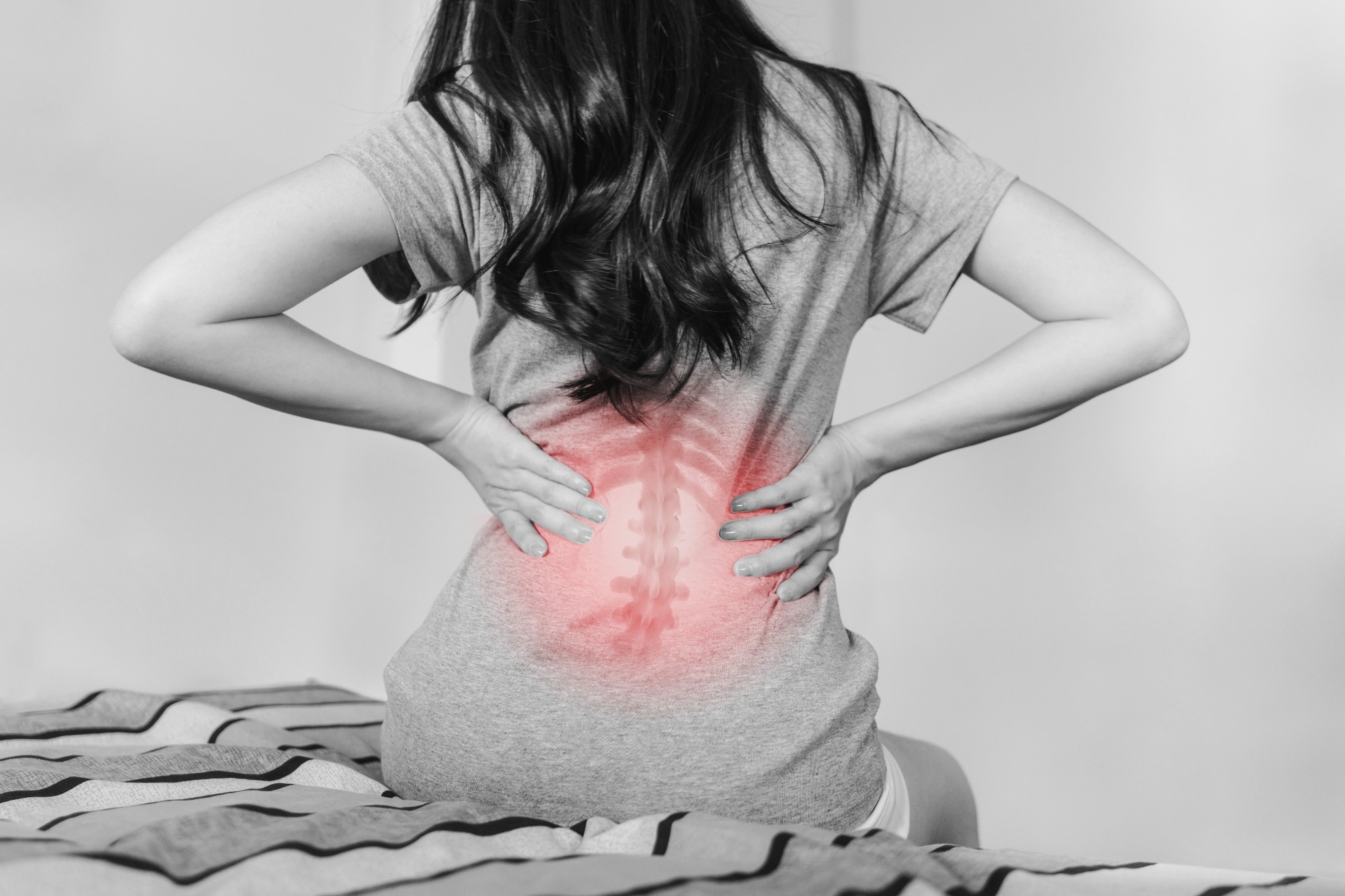Osteoarthritis (OA) pain is a significant issue among older females, with intervertebral disc (IVD) degeneration (IVDD) and facet joint OA (FJOA) common causes of this condition. The incidence of OA is two-fold greater among women than men, with menopause amplifying this difference.
Estrogen receptors are found in IVD tissues and joints, thus indicating that estrogen may be involved in OA pain. This observation has led researchers to hypothesize that estrogen supplementation could improve lower back and OA pain.
In a recent study published in Bone Research, researchers review existing evidence on the association between estrogen, IVDD, OA, FJOA, and lower back pain (LBP).
 Study: Low back pain and osteoarthritis pain: a perspective of estrogen. Image Credit: Sasan Paraksa / Shutterstock.com
Study: Low back pain and osteoarthritis pain: a perspective of estrogen. Image Credit: Sasan Paraksa / Shutterstock.com
Introduction to LBP, OA, IVDD, and FJOA
LBP and OA are significant health and economic burdens for patients, their families, and society. LBP episodes occur in the lumbar area of the vertebral column, which carries the majority of the upper body’s weight.
LBP is primarily caused by IVDD and FJOA. Women are more likely to suffer from LBP than men, with postmenopausal middle-aged females at an increased risk of suffering from LBP than younger females, likely due to hormonal changes such as estrogen reduction with age.
OA is a degenerative condition that worsens over time and ultimately results in persistent discomfort. OA often affects the body's joints, including the spine, hands, hips, and knees.
Women between 50 to 60 years of age have a four-fold greater risk of OA than similarly-aged men. Middle-aged women are also associated with a 10% and 40% greater likelihood of developing OA in the hip and knee joints than their male counterparts, respectively. Several studies have also reported that OA may be more severe in women.
LBP is influenced by various biopsychosocial and lifestyle factors. Older individuals at a greater risk of chronic pain due to reduced IVD viscoelasticity, proteoglycan synthesis, water content, structural integrity, increased oxidative stress, cell death, and senescence with age. FJOA arises due to spinal degeneration and is considered another primary cause of LBP.
Role of estrogen in OA and LBP pain
Estrogen, a steroid hormone released from human ovaries, plays a crucial role in the growth, differentiation, and normal functioning of female reproductive organs, bone health, and musculoskeletal metabolism.
Estrogen promotes bone matrix formation by increasing osteoblastic activity. This hormone can readily penetrate cellular membranes and efficiently bind with estrogen receptors (ERs).
Previous studies have shown that estrogen treatment can increase chondrocyte prostaglandin synthesis, reduce proteoglycan synthesis, and suppress cyclooxygenase-2 (COX-2) expression in cultured rabbit chondrocytes.
Estrogen deficiency may facilitate IVDD through changes in cartilage endplate remodeling and vertebral osteoporosis. In addition to IVDD, estrogen deficiency may also promote FJOA, as demonstrated in ovariectomized (OVX) mice with decreased surface area, thickness, and volume, surface subchondral bone damage, and increased osteoclasts within their subchondral bone.
Estrogen supplementation is associated with anti-inflammatory and anti-hyperalgesic effects on nucleus pulposus cells (NPCs) of IVDs in OVX murine animals with IVDD. Following estradiol (E2) supplementation, arthritic diseases within the lumbar facet joint were prevented, as was cartilage degradation.
Estrogen medication may be beneficial for the treatment of LBP by slowing or inhibiting IVDD. Estrogen levels are directly correlated to joint health and remodeling, with low estrogen levels related to increased articular soft tissue thickness and reduced bone volume among murine animals with osteoarthritis in the temporomandibular joint (TMJ).
E2/progesterone therapy can improve condylar cartilaginous and vertebral disc health, reduce joint inflammation, and diminish joint nociception. Clinical studies have indicated that estrogen supplementation can reduce the frequency of joint pain among postmenopausal females. In fact, estrogen and estrogen-related medicinal drugs have been shown to reduce the incidence and prevalence of hand, hip, and knee OA and lower arthroplasty rates.
How does estrogen alleviate IVDD, OA, and FJOA?
Estrogen inhibition pathways include the nuclear factor kappa B (NF-κB) and ER-substance P signaling pathways. Estrogen activation pathways include the phosphatidylinositol 3-kinase (PI3K)/protein kinase B (Akt) signaling pathway, ERα-AMP-activated protein kinase (AMPK)/mammalian target of rapamycin (mTOR) pathway, ERβ-p38 MAPK pathway, and ERα mitogen-activated protein kinase-extracellular signal-regulated kinase (MEK-ERK) pathways.
Estrogen inhibition pathways increase collagen (Col)-I and II and aggrecan synthesis, thereby increasing NPCs and annulus fibrosus cells (AFCs) to reduce IVDD and lower LBP ultimately. Estrogen activation pathways increase cartilage endplate cells (CEPCs) by lowering MMP levels, which are increased in LBP. Estrogen activation pathways may also improve OA by increasing mitophagy and chondrocyte counts.
Conclusions
Estrogen has a crucial role in the health of IVDs, joints, and other tissues that are implicated in OA and LBP. These findings support future studies on estrogen treatment for preventing and managing OA and LBP, particularly during times of low estrogen levels, such as the post-menopausal period.
Nevertheless, additional research is needed to understand better the biological pathways associated with estrogen-induced reductions in OA and LBP pain and the possible negative impacts of estrogen treatment. Future studies must also identify the optimal type of estrogen therapy and dosage to maximize the benefits of this hormone supplementation for diverse pain disorders.